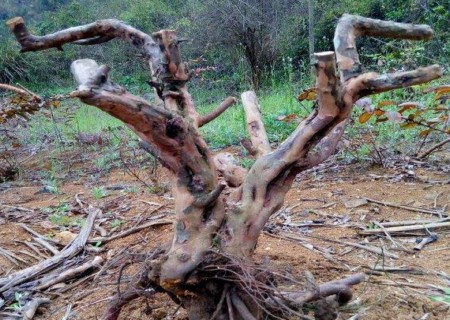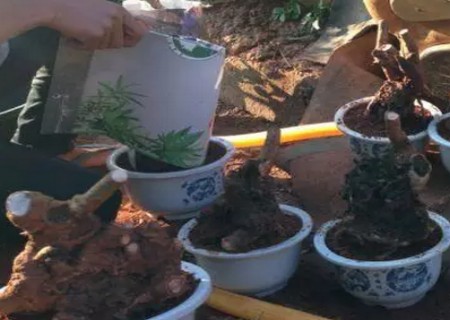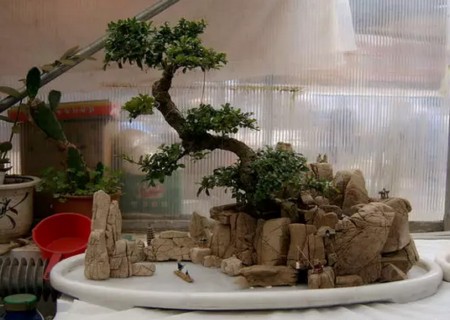Cultivation and maintenance of Finch Plum under Mountain pile
Finch plum belongs to Rhamnaceae, with peculiar roots and elegant tree posture. It is one of the main tree species of Chinese stump bonsai, one of the five famous trees in Lingnan bonsai, and one of the bonsai plants exported to the United States after China's entry into WTO. Finch plum fruit is edible, sour and sweet, hence the name sour plum fruit, tender leaves can be used instead of tea. Finch plum is native to the Yangtze River Basin and the southeast coastal provinces of China, and is also distributed in Japan and India. Its roots are naturally strange and the trees are vigorous and elegant. It is one of the main tree species of Chinese stump bonsai, one of the five famous trees in Lingnan bonsai, and one of the bonsai plants exported to the United States after China's entry into WTO.

The use of mountain wild Finch plum old root pile to make bonsai is more common, and the effect is faster. On the edge of the gully beside the rock in the low hills of the south of the Yangtze River, after years of cutting down the sprouting old piles of sparrow plum, pay attention to protecting the root system, except for the broken root, not pruning temporarily, the number and quality of the lateral root and fibrous root are the key to survival. The branches should be trimmed once, the main branches and buds should be retained, and the rest of the branches should be cut off, taking into account the shape of the stump and the shape of the future. Let's take a look at the cultivation and maintenance methods of Finch plum under the mountain pile.
I. the pile-picking period of sparrow plum
The climate in the south is warm, the dormancy period of plants is short, and the sprouting is early. The best pile picking period is from Lesser Cold to Greater Cold. After dormant, trees accumulate a lot of nutrients, which are conducive to germination and rooting. Roots and buds complement each other. The good development and growth of them is the premise and key to ensure the survival of tree stump and prevent withering and withering branches.
2. Pre-planting treatment of sparrow plum
1. Clean up the pile billet. After the green blanks are collected, the branches are removed according to the tree potential and needs, and then the old knife edge left during excavation is cut off about 10mm. After the knife edge is cut flat, the trimmed billet is washed in water with a hard brush and the skin of the root of the pile billet is cleaned and dried.
2. Disinfection extract: soak the root of the tree stump with 3/1000 potassium permanganate solution for about an hour and then dry it, and then soak the tree billet root with an aqueous solution of about 4/1000 diacetic acid for one night. it is used to replenish the moisture lost during excavation and transportation and enhance the wound healing ability.
III. Initial planting Management of Sparrow Plum
In order to plant a good sparrow plum, the first step is to get through the initial planting, which refers to the period when the tree billet goes down the hill, and it generally does not carry soil, so the root tip cells are easy to die.
In the stage of modeling and branch selection, we should pay attention to the following points:
The main results are as follows: 1. The treated tree blanks are planted in rows on the sand bed, with a distance of about 20 cm and interspersed with different sizes. The planting depth is 5 to 10 cm, depending on the size of the pile. Or use tile basin, wooden box, the principle of using basin is "better big than small, rather deep and in a hurry and shallow".
2. One month after the first planting, the broom can generally form new roots and sprouts. Three months later, it entered a stable growth period. June and July of the lunar calendar, the weather is hot, plant transpiration is fast, root dysplasia is very easy to die of heatstroke. So at noon when it is hot in summer, the tree stump must be placed in the shade, water must be drenched once in the morning and afternoon, and the whole tree will be sprayed with a sprayer at noon.
IV. Upper basin management
In daily management, it is usually based on all-day sunshine. Note: if in the greenhouse or outdoor, when the temperature rises above 35 ℃, it should be shaded. On the eve of the maintenance of the rainy day, you can remove the sand from the roots to observe the situation of rooting. At this time, the roots should grow well, and the roots should be many and long. If the new fibrous root of the root has reached 10 to 15 cm, it can be planted in the pot, do not delay time, should be finished a few days before the plum rain. The soil used in the basin should be clean and loose, preferably half of the mountain soil and half of the furnace ash, which is conducive to the survival and growth of the new pile in the basin. After potting, it should be placed in a greenhouse or in a plastic greenhouse for four to five days. And then move outside in cloudy and rainy weather.
When the sun shines on a sunny day, the new bud head does not droop is adapted to the outdoor environment and has survived. Under the condition of conventional maintenance, the new pot pile which has adapted to the outdoor environment will apply a proper amount of thin fertilizer one and a half months later according to the production situation. At this time, the length of the twig on the new pile billet is about 30 cm, and the thickness is about 2 mm. Such branches are still weak, and management should be strengthened. According to the growth situation, apply slightly thicker fertilizer and water every 10 days and a half months until the Beginning of Autumn, so that you can tie up the shape at the beginning of September of that year.
V. maintenance methods
1. Water should be adequate.
The water used is better than natural water such as river water, pond water and Rain Water. If tap water needs to be stored for a day or two, it is more appropriate to make the chlorine run away and reuse. Laundry water containing soap, and water with oil and salt should never be used.
2. Attention should be paid to fertilization
Finch plum fertilizer is applied too much, branches and leaves grow, lack of fertilizer, the branches are thin and weak, the leaves turn yellow, and are vulnerable to diseases and insect pests. Therefore, fertilization should have principles: newly planted, first pot, just changed pot, root damage within a month can not be fertilized. In spring and summer, when potted trees grow in peak season, more fertilizer must be applied. After autumn, potted trees should be applied less if they grow slowly. In winter, potted trees can stop fertilizing when they go dormant. It is not suitable to apply fertilizer around noon in rainy days or midsummer. The application of fertilizer solution is best in cloudy days or in the evening, when the basin soil is slightly dry, it is necessary to loosen the soil to facilitate the infiltration of fertilizer and water into the soil. In order to speed up the decomposition of fertilizer, it must be drenched the next morning.
3. The basin soil should be better.
The sparrow plum stump originally grew in the wild area, with well-developed roots, drought and waterlogging tolerance, once it was dug up and planted in a shallow basin close at hand, the growth conditions were limited, such as improper maintenance and easy death, so it should be taken care of very carefully. To choose a well-drained flower paste, during maintenance, the basin soil had better be thicker. Change the new soil every two years and apply some base fertilizer to protect the fertile soil in order to make the pile scene grow normally.
4. Pruning should be timely.
The general pruning time is suitable in late spring and early autumn, when the sprouting ability of sparrow plum stump is the strongest and the growth is the most prosperous. Cut off long branches, overlapping branches, cross branches, radiant branches, withered branches, diseases and insect pests at any time. However, it should be noted that in hot weather, it is easy to burn new buds, so as to roll leaves, therefore, after pruning, it is best to put it in a cool place to see strong light after sprouting normally.
5. Disease and pest control
The common diseases and insect pests of sparrow plum stumps are longicorn beetles, commonly known as "heart-drilling insects". The female longicorn beetle bites through the bark to lay eggs on the branches, and the newly hatched larvae eat under the bark and grow into the trunk and roots. the damaged plants are often eaten and withered. The location of the insect Finch plum damage can be judged according to the excretion, and the larvae can be stabbed by inserting appropriate iron wire into the wormhole, or the cotton ball plug wormhole can be soaked with 200 times solution of dichlorvos, poison the larvae with medicine, and then sealed with wet mud.
Red spider, also known as fire spider, is also a common pest of Finch plum pile scene, its body is less than 1 mm, orange-red or reddish brown oval. The red spider forms a web on the plant leaves and uses its mouthparts to pierce into the branches and leaves to absorb juice, the chlorophyll of the damaged leaves is destroyed, the color becomes yellow and pale, the leaves show fine gray-yellow spots, the leaves gradually wither and fall, and some even the whole plant leaves are stripped and withered. Can spray dichlorvos or dimethoate 1000 times liquid to 1500 times liquid, eliminate it.
Time: 2019-06-03 Click:
- Prev

Transplanting method of mountain piles under bonsai
The downhill stump, that is, the wild tree stump dug in the mountain, is used as bonsai material. In general, such materials have strange, dangerous, simple and elegant effects that are difficult to achieve by hand. Perhaps, your burning material is someone else's bonsai material. Based on his own understanding of bonsai pile transplantation for more than ten years, the editor
- Next

Illustration of the method of making tree and stone flood and drought bonsai
Tree and stone flood and drought bonsai take plants, rocks and cultivation matrix as materials, apply the creative techniques of trees and landscape bonsai respectively, combine them into scenery according to their intention, and carefully deal with the topography and landform, decorating pavilions, carts, cattle and horses, figures and other furnishings to show the waters in the basin.
Related
- Fuxing push coffee new agricultural production and marketing class: lack of small-scale processing plants
- Jujube rice field leisure farm deep ploughing Yilan for five years to create a space for organic food and play
- Nongyu Farm-A trial of organic papaya for brave women with advanced technology
- Four points for attention in the prevention and control of diseases and insect pests of edible fungi
- How to add nutrient solution to Edible Fungi
- Is there any good way to control edible fungus mites?
- Open Inoculation Technology of Edible Fungi
- Is there any clever way to use fertilizer for edible fungus in winter?
- What agents are used to kill the pathogens of edible fungi in the mushroom shed?
- Rapid drying of Edible Fungi

